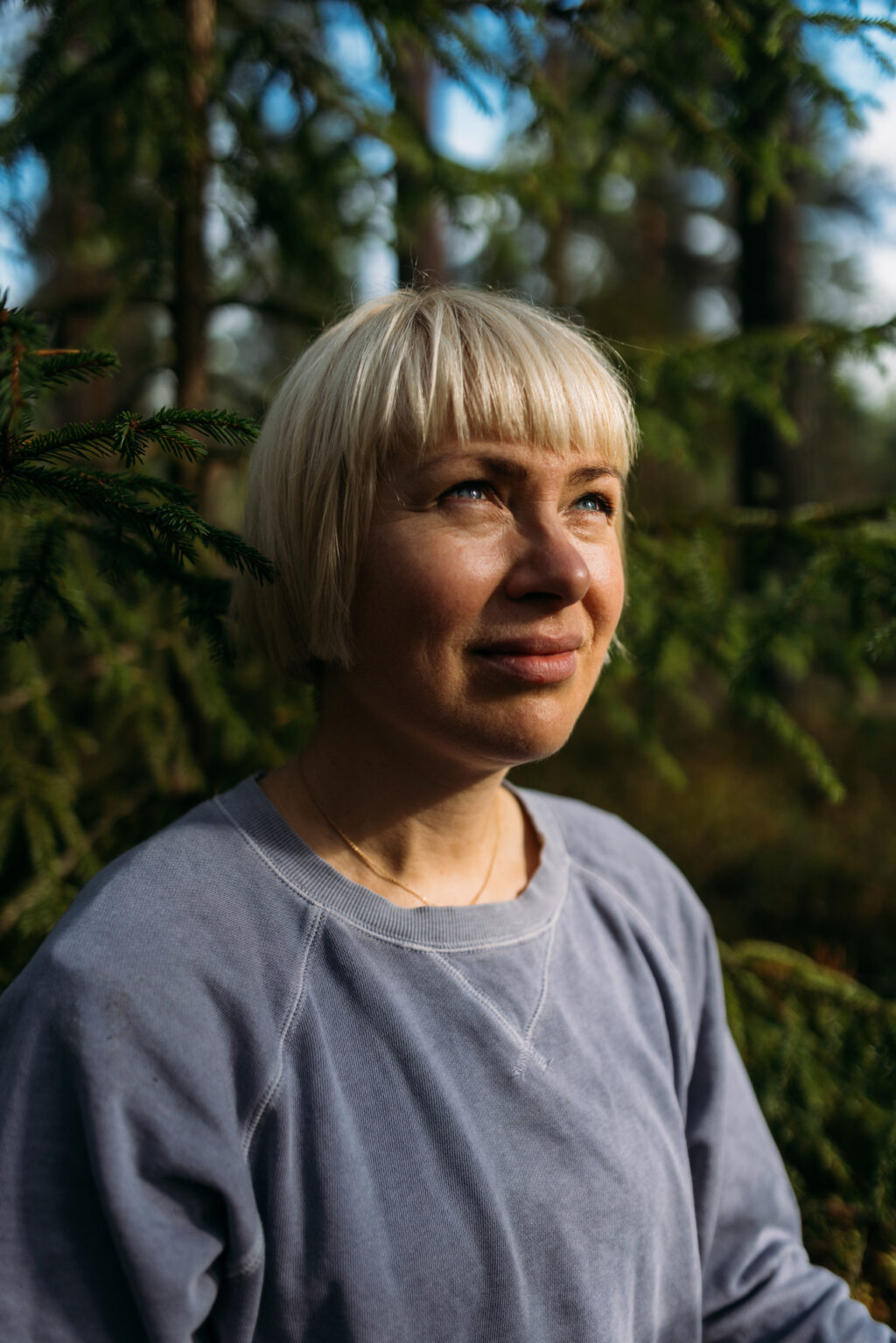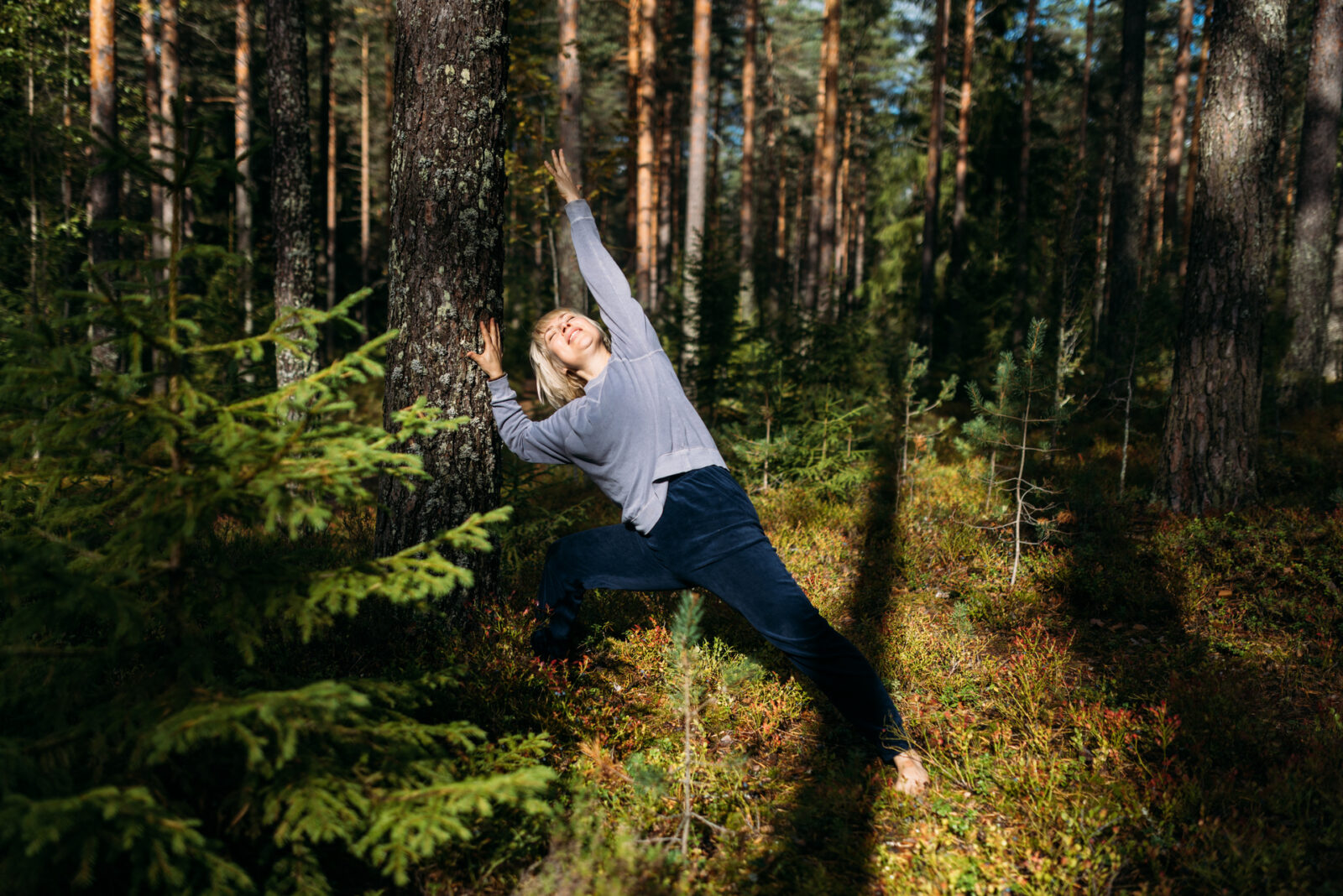Just beyond the ski hill jumping towers, you can spot outdoor enthusiasts jogging, Nordic walking, and biking through the scenic trails. However, Eeva Ratalahti guides her group slightly away from the bustling path and encourages everyone to pause and connect with the forest. Then, a unique journey begins, engaging each of our senses.
– It doesn’t matter if the distant hum of traffic or the nearby bakery fills the air. You can let these sounds pass without dwelling on the specific bird songs or car brands, she advises during an exercise focusing on our sense of hearing.
After an immersive exercise with closed eyes, we shift our attention to the close and distant surroundings, touch the earth, inhale the scent of pinecones, and perhaps even taste the forest’s offerings, such as blueberries. Once we’ve embraced the forest’s ambiance, Ratalahti invites participants to find a tree that resonates with them, against which they will perform straightforward yoga poses and synchronized breathing exercises.
– The idea here is to immerse oneself in the thought, ‘I am in the forest, I have arrived, I am home.’ Trees are the heart of the forest, and that’s why we harmonize our movements with them.
The practice continues with gentle stretches, graceful bends, sun salutations, and exercises for balance and strength, all of which can be done against the backdrop of a supportive tree. For those who prefer, shoes can be removed, or they can sit or lie on the forest floor, but it’s not a requirement. This is why Ratalahti doesn’t suggest bringing yoga mats but simply encourages everyone to enter the forest dressed in flexible outdoor attire.
The power of breath
The pace is soothing, with breath being the driving force, guiding both physical movement and mental clarity.
– As I lean against a tree and breathe in and out, my mind finds stillness, and I lose myself in the moment. The passing travelers cease to concern me. Occasionally, curious individuals may approach, inquiring about our activities. In those moments, we briefly break the silence and respond, Ratalahti warmly remarks.
During the forest yoga session, approximately 45 minutes are dedicated to silence, during which the group refrains from conversation. Some time is spent strolling through the forest, and the instructor might lead the group to a nearby pond or another captivating spot that many may not have noticed before.
The article continues after the image.

– We observe nature, but we don’t rush to explain it. Even though we are descendants of hunters and gatherers, it’s not always necessary to forage for mushrooms or identify birds.
At the end of the tranquil period, Ratalahti has the participants create mandalas from the materials provided by the forest, within the bounds of respect for nature. Cones, fallen branches, twigs, pieces of bark, berries, mushrooms, and flowers transform into circular artworks, their purpose being to return to the natural cycle.
Finally, it’s time for reflection and conversation. While many participants wish to share their forest experiences, it’s the peace and focus that stand out in their feedback.
– Many have said, “It was wonderful not having to talk” or “I feel so relaxed and calm.” At that point, I remind them that this is primarily an experiential practice that can also be done individually in one’s own nearby forest.
A brief encounter with nature
Ratalahti crafted the concept of forest yoga as part of Lahti’s designation as the European Green Capital for 2021. Already equipped with yoga instructor training and experience in meditation and various forms of art therapy, she had also been part of projects that celebrated the communal creation of art in natural surroundings.
– I realized that the forest is where I seek tranquility. The covid pandemic made the social dimension more apparent, as people were limited to outdoor gatherings at a safe distance. Numerous studies have underscored the remarkable health benefits associated with time spent in the forest.
In addition to its calming influence, the forest boasts a range of other advantages, such as the boost in immunity from exposure to forest microorganisms, and the therapeutic effects of the aromatic compounds and oils released by trees, known to alleviate various ailments. It’s no coincidence that sanatoriums in the past were often nestled in pine forests.
Despite Ratalahti’s role as a group leader, particularly during spring sessions at Wellamo-opisto, she eagerly encourages individuals to take self-guided forest breaks.
– Just a ten-minute forest walk has been shown to reduce stress significantly. Lahti is fortunate to be surrounded by nature, making it easy for everyone to seek solace in the woods.
Original text: Ina Ruokolainen
Photos: Lassi Häkkinen
This article was published in Finnish in the Kaupunkilainen magazine in October 2023.
